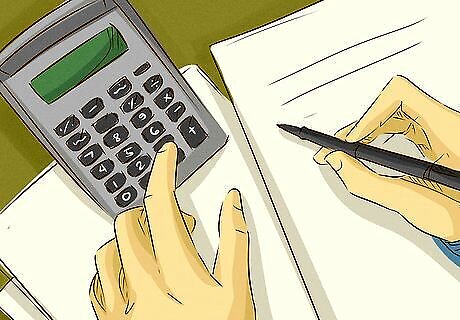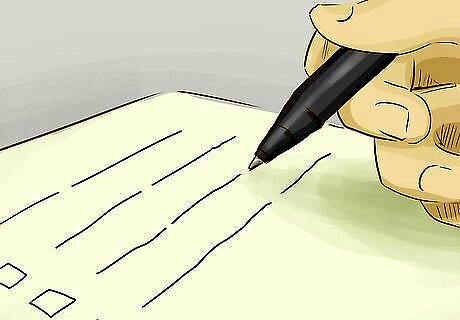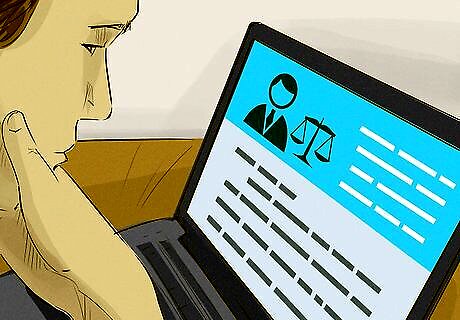
views
Creating a List of Property

Calculate the equity in your home. Many states will allow you to exempt a certain amount of equity in your home. To figure out the equity in your house, you should subtract the mortgage from the current market value. You will have equity if your house is worth more than you owe on it. The bankruptcy trustee can actually seize your house and sell it if you have equity in your home. However, you can protect it by applying a homestead exemption. If the mortgage is worth more than your house, then you have no equity. There is nothing for the trustee to seize.

Add vehicles to the list. You can try to exempt your vehicle. As with a home, the trustee will not take the vehicle if the loan amount is greater than the resale value of the car. In this situation, there is no equity in the car for the trustee to use after paying off the loan. To find out the equity in your car, visit the Kelley Blue Book website. You can find the resale value by typing in the make, model, year, and mileage on the car. Then subtract any loan from the resale value. For example, the car may have a resale value of $2,000. If you have no loan, then you have $2,000 in equity. By contrast, if you have a $500 loan remaining to be paid off, then you have $1,500 in equity.

Identify liquid assets. Liquid assets are things like cash, stocks, and bonds. If you declare for bankruptcy and you have liquid assets, the trustee can take them and apply them to your debts. Write down the present value of this property. Cash is easy—if you have $255 in your checking account, then you have $255 in cash. You can find the present value of savings bonds by visiting the United States Treasury’s website at http://www.treasurydirect.gov/BC/SBCPrice. You can find the value of stock by contacting a stock broker.

Create a list of personal property. You should also go through your personal property. Start with big items, like computers, televisions, exercise equipment, furniture, etc. Then work down and list smaller items, such as books and kitchen supplies. You can usually keep clothing during your Chapter 7 bankruptcy. To value personal property, look online and check to see how much goods sell for. You could also visit thrift or salvage stores and check the prices. Write down the day and time you visited. You also could have an appraisal done. You might want to use this option if the value of your furnishings is low compared to the value of your home. Reporting personal property of $3,000 when you have a million-dollar home could raise eyebrows. In that situation, you want to have an appraisal done.
Finding Exemptions

Read your state law. Most states have created exemption schemes for bankruptcy. You should read your state law to see what exemptions are available. You can find your state law by searching the Internet. Type “your state” and “bankruptcy exemptions” into your favorite web browser. Then scroll through the results. You might also want to stop into your nearest law library. It should be either at the courthouse or at your nearest law school. Tell the librarian that you are looking for your state’s bankruptcy exemptions. The librarian should help you find the information.

Look for a homestead exemption. You should first check whether your state allows a homestead exemption. Most states do. The amount will vary, depending on the state. In Kentucky, for example, you can only exempt up to $5,000 in your home ($10,000 if applying for bankruptcy as a married couple). In Alaska, however, you can exempt $70,200 worth of equity in your home. The federal government also allows a homestead exemption. It is worth $22,975 for single people and $45,950 for married couples who file bankruptcy jointly. If the equity you have in your home exceeds the homestead exemption, then you might have to apply other exemptions (like a wildcard exemption). If the trustee ultimately sells your house, you will get back the value of the exemption. Also check if you can apply any left-over homestead exemption to other property. For example, your state might give a $20,000 homestead exemption. If you only have $10,000 in equity you need to protect, then you have $10,000 leftover in an unused homestead exemption. Some states will then allow you to use some or all of a leftover homestead exemption and apply it to other property.

Identify any motor vehicle exemption. Many states have exemptions for equity in motor vehicles. You should check to see how much your state exempts. The amounts differ widely. In Colorado, for example, you can exempt up to $5,000 or up to $10,000 if you are disabled. Married couples in Colorado can double the amount of their exemption. In Nevada, by contrast, you can exempt up to $15,000 (doubled if you file jointly with a spouse). If you are disabled, then you can exempt an unlimited amount of equity. The federal government also allows an exemption of $3,675.

Look for other categorical exemptions. Some states offer exemptions for categories of goods, such as “household furnishings.” Other common categories include: Tools of the trade: these are business assets, including machinery, tools, equipment, and working animals. Cash: generally, cash is part of your bankruptcy estate. However, some states may have exemptions for cash or for cash that was paid in the form of wages. Retirement plans. Some retirement plans may be protected by a categorical exemption, whereas others may not be.

Find a wildcard exemption. Some states and the federal government also provide for a “wildcard” exemption. This amount can be applied to any property that you choose. For example, you can add it on top of your motor vehicle exemption. If your state allows you to exempt $5,000 in motor vehicle equity, then you could add an additional $2,000 wildcard exemption. In total, you would then exempt $7,000 in equity in your motor vehicle. You can also apply the wildcard exemption to any property which isn’t covered by a categorical exemption. The federal wildcard exemption is $1,225 for an individual and double for couples. If you are allowed to use any unused portion of your homestead exemption on property of your choosing, then that is essentially a wildcard.
Getting Legal Help

Find a bankruptcy lawyer. You should hire a bankruptcy lawyer to help you file your bankruptcy petition. Your lawyer can also help you decide whether to use your state’s exemptions or the federal exemptions. You generally have to choose between the two—your state’s exemptions or the federal exemptions. You cannot typically mix and match exemptions. You will have a better chance of successfully petitioning for bankruptcy if you use a lawyer. Studies show that around 95% of people represented by a lawyer successfully file for bankruptcy. Those who file without a lawyer succeed only 61% of the time. To find a bankruptcy lawyer, you can contact your state’s bar association, which should run a referral program.

Meet for a consultation. Most lawyers will provide a consultation which should last 15-30 minutes. At the consultation, you can ask any questions you have and get your lawyer’s advice. When you call for a consultation, you should ask whether the lawyer charges a fee. Some lawyers provide free consultations. Others might charge a small fee (around $50). You should think about paying the fee. Free consultations sometimes are little more than sessions where the lawyer tries to sell you his or her business. If you pay a fee, then the lawyer might be more willing to answer your questions. You might plan on representing yourself in bankruptcy. If so, then you could use a reduced-fee half-hour consultation to get answers to your questions. Then you can proceed to file the bankruptcy petition yourself.

Apply your exemptions. When you file your bankruptcy petition, you need to list all of your property on various forms (Schedules A and B). You will then need to claim your exemptions on Schedule C, which is Form B 106C. You must include: a brief description of the property the current value of the property the exemption amount the specific state or federal law that allows the exemption




















Comments
0 comment